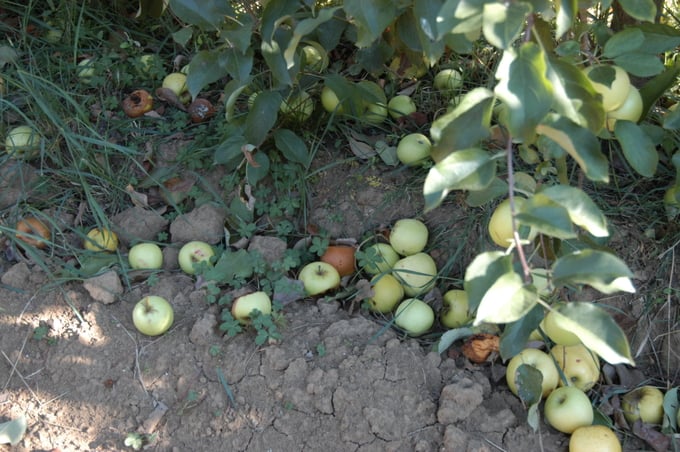November 27, 2025 | 18:52 GMT +7
November 27, 2025 | 18:52 GMT +7
Hotline: 0913.378.918
November 27, 2025 | 18:52 GMT +7
Hotline: 0913.378.918
Interview with Rosa Rolle, Team Leader, Food Losses and Waste, Food and Agriculture Organization of the United Nations (FAO).

Fallen apples rotting on the ground
Food loss and food waste is a pressing challenge globally and if left unchecked will have severe consequences for climate, food security and management of natural resources, experts say.
With global hunger on the rise and surging food prices, this is an issue that should not be ignored, they warn.
Food loss, as reported by the Food and Agriculture Organization of the United Nations (FAO) in the Food Loss Index, occurs from post-harvest up to, but not including, the retail level.
Food waste refers to the decrease in the quantity or quality of food resulting from decisions and actions by retailers, food service providers and consumers.
Across the globe, 14 percent of food is lost in the supply chain prior to retail and a further 17 percent is wasted in retail and consumption.
Ahead of the third International Day of Awareness of Food Loss and Waste on 29 September 2022, we speak to Rosa Rolle, Team Leader, Food Losses and Waste, Food and Agriculture in FAO’s Food and Nutrition Division, to understand a bit more about the problem and what can be done to tackle it.
These are tumultuous times. Our global food systems have been disrupted by two years of the COVID-19 pandemic, climate change and the war in Ukraine, pushing millions of people into food insecurity with hunger and malnutrition on the rise.
The report: The State of Food Security and Nutrition in the World 2022, shows that the number of people affected by hunger globally rose steeply to as much as 828 million in 2021.
Food loss has a high environmental footprint. It squanders scarce resources used to produce food including water, soil and energy, labour and time, while producing greenhouse gas emissions. All of this exacerbates climate change and threatens agricultural sustainability, human livelihoods and the quality and safety of our food supplies.
Today, approximately 31 percent of total greenhouse gas emissions are attributable to the agrifood system. These emissions originate from production, processing, packaging, transport, storage, consumption and the disposal of food. They are generated regardless of whether food produced is consumed, discarded or wasted.
Increased levels of carbon dioxide and other greenhouse gases in the atmosphere contribute to an unstable climate that is often prone to drastic environmental change and extreme weather events, including increasing temperatures or global warming, droughts and flooding.
When it comes to food loss, there are several challenges we face, as the highest levels of losses take place in the so called “traditional food supply chains” that are managed by smallholder farmers in developing regions. Poor planning and organization plague the smallholder production sector.
Supply chain stakeholders often have limited knowledge on how to handle food items post-harvest. Post-harvest technologies and infrastructure support are often either inadequate or non-existent. Links to markets are underdeveloped and often policies aren’t in place to address these issues. Stakeholders in these supply chains lack financial resources and are unable to access credit to upgrade their operations.
Reducing food loss and waste is central to mitigating climate change, to slashing greenhouse gas emissions and to making more efficient use of our natural resources.
There is the need to work toward increasing the resilience of agrifood systems to allow them to anticipate, prevent, adapt and transform in the face of any disruption. This will protect food security, livelihoods and nutrition for all.
Improvements in processing, cool and dry storage for example - would go a long way to reducing losses and improving the quality and availability of food, thereby building climate resilience upstream in the food supply chain where food losses are prevalent.
This would reduce emissions associated with the clearing of land to increase production output, make more efficient use of our natural resources, increase food availability and access, protect the income of farmers and small holders and contribute to improving dietary quality
Reducing food losses has the potential to generate win-wins across all dimensions of hunger targets in that it improves food availability and access, protects the income of farmers and smallholders and improves dietary quality.
Reducing food loss and waste is a programme priority area in FAO’S Strategic Framework 2022 – 31 in support of the 2030 Agenda.
FAO, through its current work, is supporting countries to identify and overcome challenges by filling in knowledge and capacity gaps, helping to strengthen policy, regulatory and institutional frameworks that enhance the competitiveness of smallholders, even in their local markets.
(Fao.org)

(VAN) A new study reveals how the simultaneous effects of ocean acidification, salinity and loss of oxygen are making the world more fragile.

(VAN) Hopes are growing that the creation of the first 3D turkey gut model could be a turning point in the battle against the virulent blackhead disease.

(VAN) Tyson, America’s biggest meat supplier, plans to shutter one of its largest beef processing plants as the industry continues to struggle with low cattle supplies and political pressure from Washington.

(VAN) New FAO study shows how digital solutions are empowering farmers and fishers to prevent losses and build resilient agrifood systems.

(VAN) Brazil's COP30 presidency pushed through a compromise climate deal on Saturday that would boost finance for poor nations coping with global warming but that omitted any mention of the fossil fuels driving it.

(VAN) Poultry farmers in the UK have been warned that they could face one of the worst winters yet for bird flu.

(VAN) Prices of main-crop paddy have risen sharply, with jasmine rice hitting 16,100 baht per tonne — the highest level in years.